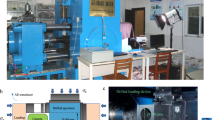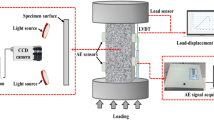Abstract
The fracturing of six granite cubes (400 × 400 × 400 mm3) in response to blast loading was investigated using a combination of data collected from strain gauges and generated by digital image correlation (DIC) of pictures captured using a high-speed camera. This instrumentation permits the observation of the crack initiation, crack opening velocity, fracture pattern, full-field strain variation, and fragment movement at the cube’s surface. In each experiment, an explosive charge was positioned at the center of the block in a vertical drill hole. Two charge weights, 6 g and 12 g, of pentaerythritol tetranitrate (PETN) were used. Using the high-speed camera, dominant vertical cracks were found to initiate on the surface of the cubes within 250 µs of the charge detonation. Two or three dominant vertical cracks appeared in specimens with a 12 g charge, while a single dominant vertical crack came into view in specimens with a 6 g charge. In addition, a single dominant horizontal crack was observed in all specimens, irrespective of charge weight. The maximum concentration of strain obtained from a DIC analysis agreed well with the dominant cracks and fracture patterns observed in the specimens. By combining the results from the strain gauges and the results from the DIC analysis for the specimen with a 12 g charge, the first crack initiation was found to occur at 67 µs after detonation. The crack opening velocities were determined using a boundary identification method and ranged from 5.0 to 7.6 m s−1, whereas the observed in-plane fragment velocities were slightly less. These experiments may contribute to a better understanding of the fundamental mechanisms of the rock fracture by blasting.












Similar content being viewed by others
Abbreviations
- Δε xx, Δε yy :
-
Strain errors for the x component and y component
- ε 1st, ε cr :
-
First principal strain and critical strain
- α, β :
-
Crack direction angles
- θ :
-
Angle of fragment movement
- V f :
-
Fragment velocity
- Z, ΔZ :
-
Object distance and out-of-plane displacement
References
Ainalis D, Kaufmann O, Olivier JT, Kouroussis G (2017) Modelling the source of blasting for the numerical simulation of blast-induced ground vibrations: a review international organisation for standardisation. Rock Mech Rock Eng 50:171–193. https://doi.org/10.1007/s00603-016-1101-2
Banadaki MMD (2010) Stress-wave induced fracture in rock due to explosive action. University of Toronto, Toronto
Bergmann OR, Riggle JW, Wu FC (1973) Model rock blasting-effect of explosives properties and other variables on blasting results. Int J Rock Mech Min Sci 10:585–612. https://doi.org/10.1016/0148-9062(73)90007-7
Bieniawski ZT (1968) Fracture dynamics of rock. Int J Fract Mech 4:415–430
Bornert M, Brémand F, Doumalin P et al (2009) Assessment of digital image correlation measurement errors: methodology and results. Exp Mech 49:353–370
Bornert M, Vales F, Gharbi H, Nguyen Minh D (2010) Multiscale full-field strain measurements for micromechanical investigations of the hydromechanical behaviour of clayey rocks. Strain 46:33–46
Cadoni E (2010) Dynamic characterization of orthogneiss rock subjected to intermediate and high strain rates in tension. Rock Mech Rock Eng 43:667–676
Chi L, Aalberg A, Zhang ZX et al (2018) An experimental investigation on dynamic responses of granite blocks under blast loading. In: Li C, Li X, Zhang Z (eds) Proceedings of the 3rd international conference on rock dynamic and applications. Taylor & Francis Group, Trondheim, pp 623–628
Chiapetta RF, Borg DG (1983) Increasing productivity through field control and high-speed photography. In: Proceedings, 1st international symposium on rock fragmentation by blasting, Lulea, Sweden, pp 301–331
Chou PC, Koenig HA (1966) A unified approach to cylindrical and spherical elastic waves by method of characteristics. J Appl Mech 33:159–167
Dai F, Xia K (2010) Loading rate dependence of tensile strength anisotropy of Barre granite. Pure Appl Geophys 167:1419–1432. https://doi.org/10.1007/s00024-010-0103-3
Dai F, Huang S, Xia K, Tan Z (2010) Some fundamental issues in dynamic compression and tension tests of rocks using split Hopkinson pressure bar. Rock Mech Rock Eng 43:657–666. https://doi.org/10.1007/s00603-010-0091-8
Field JE, Ladegaard-Pedersen A (1971) The importance of the reflected stress wave in rock blasting. Int J Rock Mech Min Sci Geomech Abstr 8:213–226
Fourney WL (2015) The role of stress waves and fracture mechanics in fragmentation. Blasting Fragm 9:83–106
Fourney WL, Dally JW, Holloway DC (1974) Stress wave propagation from inclined line charges near a bench face. Int J Rock Mech Min Sci Geomech Abstr 11:393–401
Goldsmith W, Sackman JL, Ewerts C (1976) Static and dynamic fracture strength of Barre granite. Int J Rock Mech Min Sci Geomech Abstr 13:303–309
Grimsmo EL, Clausen AH, Aalberg A, Langseth M (2017) Fillet welds subjected to impact loading—an experimental study. Int J Impact Eng 108:101–113
Hedan S, Cosenza P, Valle V et al (2012) Investigation of the damage induced by desiccation and heating of Tournemire argillite using digital image correlation. Int J Rock Mech Min Sci 51:64–75
Holloway DC (1982) Application of holographic interferometry to stress wave and crack propagation problems. Opt Eng 21:213468
Isaac P, Darby A, Ibell T, Evernden M (2017) Experimental investigation into the force propagation velocity due to hard impacts on reinforced concrete members. Int J Impact Eng 100:131–138
Kim H, Lee J, Ahn E et al (2017) Concrete crack identification using a UAV incorporating hybrid image processing. Sensors 17:2052
Kutter HK, Fairhurst C (1971) On the fracture process in blasting. Int J Rock Mech Min Sci Geomech Abstr 8:181–202. https://doi.org/10.1016/0148-9062(71)90018-0
Lattanzi D, Miller GR (2012) Robust automated concrete damage detection algorithms for field applications. J Comput Civ Eng 28:253–262
Lenoir N, Bornert M, Desrues J et al (2007) Volumetric digital image correlation applied to X-ray microtomography images from triaxial compression tests on argillaceous rock. Strain 43:193–205
Munoz H, Taheri A (2017) Local damage and progressive localisation in porous sandstone during cyclic loading. Rock Mech Rock Eng 50:3253–3259. https://doi.org/10.1007/s00603-017-1298-8
Munoz H, Taheri A, Chanda EK (2016a) Fracture energy-based brittleness index development and brittleness quantification by pre-peak strength parameters in rock uniaxial compression. Rock Mech Rock Eng 49:4587–4606. https://doi.org/10.1007/s00603-016-1071-4
Munoz H, Taheri A, Chanda EK (2016b) Pre-peak and post-peak rock strain characteristics during uniaxial compression by 3D digital image correlation. Rock Mech Rock Eng 49:2541–2554. https://doi.org/10.1007/s00603-016-0935-y
O’keefe SG, Thiel DV (1991) Electromagnetic emissions during rock blasting. Geophys Res Lett 18:889–892
Olsson M, Nyberg U, Fjelborg S (2009) Controlled fragmentation in sublevel caving—first tests. Swebrec Rep 2:37 (in Swedish)
Onederra IA, Furtney JK, Sellers E, Iverson S (2013) Modelling blast induced damage from a fully coupled explosive charge. Int J Rock Mech Min Sci 58:73–84
Raina AK, Murthy V, Soni AK, Soni AK (2015) Estimating flyrock distance in bench blasting through blast induced pressure measurements in rock. Int J Rock Mech Min Sci 76:209–216
Reu PL, Miller TJ (2008) The application of high-speed digital image correlation. J Strain Anal Eng Des 43:673–688. https://doi.org/10.1243/03093247JSA414
Sanchidrián JA, Segarra P, López LM (2007) Energy components in rock blasting. Int J Rock Mech Min Sci 44:130–147. https://doi.org/10.1016/j.ijrmms.2006.05.002
Seah CC (2006) Penetration and perforation of granite targets by hard projectiles. Department of Structural Engineering, Norwegian University of Science and Technology, Trondheim
Segarra P, Sanchidrián JA, López LM (2003) Analysis of bench face movement in quarry blasting. In: Holmberg R (ed) The 2nd world conference on explosives and blasting technique. Balkema, Rotterdam, pp 485–495
Sun C (2013) Damage zone prediction for rock blasting. Department of Mining Engineering, University of Utah, Salt Lake City
Sutton MA, Yan JH, Tiwari V et al (2008) The effect of out-of-plane motion on 2D and 3D digital image correlation measurements. Opt Lasers Eng 46:746–757
Sutton MA, Orteu JJ, Schreier H (2009) Image correlation for shape, motion and deformation measurements: basic concepts, theory and applications. Springer Science & Business Media, Berlin
Taylor LM, Chen E-P, Kuszmaul JS (1986) Microcrack-induced damage accumulation in brittle rock under dynamic loading. Comput Methods Appl Mech Eng 55:301–320
Tilert D, Svedbjörk G, Ouchterlony F et al (2007) Measurement of explosively induced movement and spalling of granite model blocks. Int J Impact Eng 34:1936–1952. https://doi.org/10.1016/j.ijimpeng.2006.11.006
Wang L (2011) Foundations of stress waves. Elsevier, Amsterdam
Wang C, Ding J, Tan S, Han W (2015a) High order numerical simulation of detonation wave propagation through complex obstacles with the inverse Lax–Wendroff treatment. Commun Comput Phys 18:1264–1281. https://doi.org/10.4208/cicp.160115.150915a
Wang C, Dong X, Shu CW (2015b) Parallel adaptive mesh refinement method based on WENO finite difference scheme for the simulation of multi-dimensional detonation. J Comput Phys 298:161–175. https://doi.org/10.1016/j.jcp.2015.06.001
Wilson WH, Holloway DC (1987) Fragmentation studies in instrumented concrete models. In: 6th ISRM congress. International Society for Rock Mechanics, Salzburg
Wimmer M, Nordqvist A, Ouchterlony F et al (2012) Burden movement in confined drift wall blasting tests studied at the LKAB Kiruna SLC mine. In: International symposium on rock fragmentation by blasting: 24/11/2012-29/11/2012. CRC Press/Balkema, Boca Raton/Avereest, pp 373–383
Zhang ZX (2016) Rock fracture and blasting: theory and applications. Butterworth-Heinemann, Oxford
Zhang ZX (2017) Kinetic energy and its applications in mining engineering. Int J Min Sci Technol 27:237–244
Zhang QB, Zhao J (2013) Determination of mechanical properties and full-field strain measurements of rock material under dynamic loads. Int J Rock Mech Min Sci 60:423–439. https://doi.org/10.1016/j.ijrmms.2013.01.005
Zhang QB, Zhao J (2014) A review of dynamic experimental techniques and mechanical behaviour of rock materials. Rock Mech rock Eng 47:1411–1478
Zhang ZX, Kou SQ, Yu J et al (1999) Effects of loading rate on rock fracture. Int J Rock Mech Min Sci 36:597–611
Acknowledgements
This work was financially supported by the University Centre in Svalbard. The authors wish to thank Dr. G. Gilbert at the University Centre in Svalbard for valuable inputs to manuscript, and Mr. C. L. He, Mr. Z. Y. Cheng, Mr. Z. S. Zhou and Mr. Feng at the Beijing Institute of Technology for the support in performing the experiments at the State Key Laboratory of Explosion Science and Technology. The authors thank the anonymous reviewers for their valuable comments and suggestions.
Author information
Authors and Affiliations
Corresponding author
Additional information
Publisher’s Note
Springer Nature remains neutral with regard to jurisdictional claims in published maps and institutional affiliations.
Rights and permissions
About this article
Cite this article
Chi, L.Y., Zhang, Z.X., Aalberg, A. et al. Fracture Processes in Granite Blocks Under Blast Loading. Rock Mech Rock Eng 52, 853–868 (2019). https://doi.org/10.1007/s00603-018-1620-0
Received:
Accepted:
Published:
Issue Date:
DOI: https://doi.org/10.1007/s00603-018-1620-0




